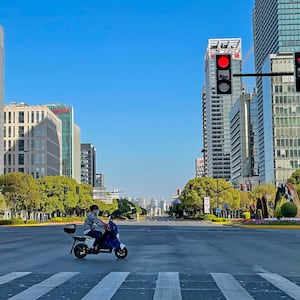Residents of the beleaguered Chinese city of Shanghai are panic buying once again after government workers started erecting high fences to lock in residential districts in its increasingly desperate battle to contain COVID-19.
Residents of the city of more than 27 million people were recently freed from a months-long lock down that was characterized by people screaming from their high rise buildings in protest. The new lock down threat comes after just 11 new cases were found outside quarantine centers as Beijing demands mass testing.
Three of the infections were traced to the Red Rose beauty salon, which has served more than 500 customers since Shanghai reopened June 1. All of those patrons will have to be tested, according to Chinese state media. Wang Hongwei, a local party official in the Xuhui district where the salon is located, told Chinese state media that they were investigating reports that one of the workers did not take a PCR test, as is required for anyone working in the public sphere.
ADVERTISEMENT
Chinese officials also put Beijing on high alert and shut down a number of entertainment venues, according to the Guardian. Speaking on state media, Chinese president Xi Jinping promised citizens that the pain would be worth it and promised to “resolutely overcome some of the difficulties” associated with the closures. “Persistence is victory,” he said. “We must unswervingly adhere to the general policy of ‘dynamic clearing,’ strengthen confidence, eliminate interference, overcome paralyzing thoughts, pay close attention to the key tasks of epidemic prevention and control, and resolutely consolidate the hard-won results of epidemic prevention and control.”
China—where COVID-19 was first detected in late 2019—remains one of the last countries still applying strict measures and the only nation still forcing people to lock down. Contact tracing, mass quarantine centers and mandatory testing have all been increased in China’s major cities. While much of the rest of the world’s countries consider close contacts those who live in the same dwelling, Chinese policy tends to include anyone who lives in the same section of a building—even on different floors.
The costs of China’s zero-COVID policy are expected to be measured in losses to its economy, with expectations now low that it will meet growth targets. Shutdowns are expected to also test the global supply chain as key production factories face difficulty keeping up with demand.
Still, Beijing says it will force around 14 million—a little over half of Shanghai’s residents—to quarantine for two days and then be tested for 12 days for any variant of the coronavirus over the weekend. High fences were put in place to make sure people comply. Notices received by residents that they are part of the testing sample sent people into a panic. During the last lock down, many Shanghai residents ran out of food, or faced long waits getting groceries delivered. This time, they seem to be far more prepared for what is by now all too familiar.
China’s National Health Commission logged just 73 new cases across the country on Friday, including the 11 in Shanghai and eight in Beijing.





